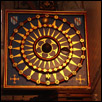east devon
East Devon includes the start of the so-called Jurassic coast, plus some lovely countryside or what John Prescott would call potential building sites.
The historic city of Exeter, on the River Exe, is the county capital. The area was occupied by people from at least Palaeolithic times; related stone tools have been found in various parts of the city. Under Roman occupation a fort was established here. Its historic port is at Topsham, 5 miles away, then used by the occupying power for transporting supplies via the the Quayside.
Not until the end of the Civil War of 1642-1647 did the defensive city wall fall into disrepair. After the 1760s the city's gates were abandoned, regarded as being an anachronism in modern times. When, early in the C5th, the Roman occupation ended, Exeter went into a decline. Research indicates that large-scale volcanism in Asia caused widespead similar declines not only in Europe but globally; temperatures dropped and lower light-levels brought about crop failures and famine.
Down Mint Street, on the left-hand side of Fore Street walking uphill towards the historic Guildhall, is St. Nicholas Priory. A Benedictine monastery was built here from 1068, and dedicated to St. Nicholas in 1087. The Priory was used by the monks to shelter and feed travellers and pilgrims. After the dissolution of the monasteries in 1536 those buildings still standing, including this one, were sold by the Crown. At one time it was in private ownership. In 1913 Exeter city bought it for restoration. Later it opened as a museum. Currently (April 2006) it's closed for further work but should reopen around 2007.
The Cathedral Church of St. Peter has a spacious green and a charming Cathedral Close, popular with visitors, tired shoppers and pigeons. The lovely cathedral itself dates from about 1050. Saint Boniface (of Crediton fame) was educated at a monastery here. Markets and games used to take place here in the Middle Ages, the crowds being an encitement to thieves and pickpockets. Much like in some places today! Many buildings from this period can be found, among them a cottage in cobbled Stepcote Hill. In 1942 the cathedral was bombed during the Blitz. Among the city's churches is that of St. Andrew and All Saints. Today's city is lively and busy, with much public wall art, as well as history.
Budleigh Salterton is an engaging and busy small town with a stunning coastline. Sir Walter Raleigh was born nearby and must have spent many boyhood hours in the town and along the coast. A painting called "The Boyhood of Raleigh" by Sir John Everet Millais, is in London's Tate Gallery. The pepple beach and the red cliffs form part of the Jurrassic Coast World Heritage Site. The picturesque River Otter estuary can be seen behind the beach. Salterton derives from the days when salt-panning was carried out in the area. The town was known as Ottermouth at that time.
Fascinating information about Budleigh Salterton and its literary connections are on this page.
Markers Cottage is a mediaeval cob and thatched cottage within the pretty village of Broadclyst, five miles from Exeter. Now that its population is heading for 3000, I suppose it must count as a small town. The river Clyst flows through. Inside the cottage is a cross-passage screen including a painted landscape featuring St. Andrew. In the garden is a thatched, cob summerhouse.
Named for the river Otter, which runs alongside it, Ottery St. Mary is famous both for its church and its renowned son, Samuel Taylor Coleridge.
The Church of St. Mary of Ottery is in the Otter valley, about 12 miles from Exeter. Its mediaeval grandeur dominates the small town. The manor of Otrei was mentioned in the Domesday Book of 1086. It's not known whether a church existed then, but it did by the mid C12th. Over the centuries periodic restoration has been undertaken, which is still ongoing.
Samuel Taylor Coleridge, poet, critic and philosopher, was born in Ottery St. Mary. He became one of the founders of the C18th Romantic Movement and one of the Lakes Poets, along with his friend William Wordsworth and the poet Robert Southey. His best-known poems are probably The Rime of the Ancient Mariner, Kubla Khan, and Christabel, the last two being unfinished. He died in London's Highgate.
Admirers of the poet were the parents of another Samuel Coleridge-Taylor, born 1875 and died 1912, after whom they named their musically gifted son, who became known as The Black Mahler. The musician had an African father and an English mother. His surname is hyphenated.














